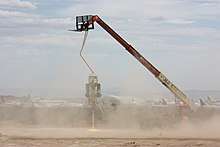Tethered flight test
A tethered flight test is a type of flight testing where a machine is connected by a tether to the ground. Tethered testing may be used when motion through the atmosphere is not required to sustain flight, such as for airship;[1] vertical take-off and landing (VTOL), rotary wing or tiltwing aircraft (tethered hovering);[2] or for tests of certain rockets, such as vertical takeoff, vertical landing (VTVL). Fixed wing scale models can be tested on a tether in a wind tunnel, simulating motion through the atmosphere.[3]


History
Numerous vertical take-off and landing (VTOL) aircraft conducted their initial flights while tethered. Early vertical flights of the Short SC.1, an early experimental aircraft that was the first British fixed-wing VTOL aircraft as well as the first one to transition between vertical and horizontal flight modes.[4][5] For these flights, a custom-built gantry was developed that accommodated only a limited amount of freedom, up to 15 ft vertically and 10 ft off-centre in any direction, vertical velocity was also restricted to less than 10 ft/second; progressive arresting of the aircraft occurred beyond these limitation.[6] It would take off from a grid platform positioned 6 ft above the ground itself in order to circumvent the ground effect phenomenon; considerable effort on the part of Shorts had been made during development of a suitable platform to eliminate the negative impact of ground effect and was redesigned several times. The gantry facility was used for ab initio training and familiarisation purposes for the first 8 pilots to fly the SC.1.[7]
Insight from the SC.1 heavily influenced the Hawker Siddeley P.1127, the forerunner to the Hawker Siddeley Harrier VTOL fighter.[8] Its initial flights were also performed while tethered; such flights were largely conducted so that test pilots could familiarise themselves with the aircraft's controls in hover in a less risky environment. As confidence in the aircraft's handling grew, tethered flights without the aid of its onboard auto-stabiliser system were conducted.[8] Finally, on 19 November 1960, the first un-tethered free-flight hover of a P.1127 took place; flight testing of the type proceeded over the rest of the decade ahead of the first production aircraft being introduced to service in 1969.[9][10]
Numerous VTOL aircraft that would eventually be cancelled mid-development underwent tethered test flights. A pair of prototype EWR VJ 101 fighters were produced, the first performing its first hovering flight on 10 April 1963.[11] Prior to this, the VJ 1010's propulsion concept had been evaluated on a specially-produced test rig, often informally referred to as the Wippe (seesaw), during the early 1960s; it incorporated a rudimentary cockpit fixed upon a horizontal beam, which had a "lift" engine mounted vertically at the centre, for the purpose of performing preliminary single-axis tests of the control system.[12] A second "hover rig" was later assembled, possessing the skeletal fuselage of the VJ 101C along with a total of three Rolls-Royce RB108 engines installed in the approximate positions that they would occupy in the final flight-capable version and capable of lifting the test rig. Starting in May 1961, initial testing was conducted from a telescopic column, in March 1962, the new rig conducted its first "free flight" successfully.[13]
The experimental Dassault Balzac V, a forerunner to the larger Dassault Mirage IIIV, was another experimental VTOL aircraft. The Balzac commenced tethered hover flights on 12 October 1962, and achieved the first free-hover only six days later; flight testing of the type ended in September 1965 following an accident.[14][15] The Yakovlev Yak-36, an experimental VTOL aircraft developed in the Soviet Union as a forerunner to the Yakovlev Yak-38 production carrier aircraft, was also subject to a number of tethered flights in advance of freely hovering.[16] During early development work for the Ryan X-13 Vertijet, test rigs were repeatedly flown via remote control while tethered.
References
Citations
- Botting, D.; Books, Time-Life (1980). The giant airships. Epic of flight. Time-Life Books. ISBN 978-0-8094-3272-1.
The first rigid airship ever to be flown was built in the 1890s with a skeleton and outer cover made of an exotic new metal: aluminum. The new ship, designed by David Schwarz, a Dalmatian timber merchant, lifted off successfully in a tethered test in Berlin on November 3, 1897...
- Cooke, A.; Fitzpatrick, E. (2009). Helicopter Test and Evaluation. AIAA Education. Wiley. p. 103. ISBN 978-1-4051-7254-7.
- Galison, P.; Roland, A. (2013). Atmospheric Flight in the Twentieth Century. Archimedes. Springer Netherlands. p. 81. ISBN 978-94-011-4379-0.
- "Short SC1 experimental vertical take-off aircraft, 1956." Science Museum, Retrieved: 15 January 2017.
- "Short SC1 vertical take-off aircraft receives Northern Ireland’s first Engineering Heritage Award." Institute of Mechanical Engineers, 5 October 2012.
- Lean and Chinn 1965, p. 8.
- Lean and Chinn 1965, pp. 8–9.
- Mason 1967, p. 7.
- Mason 1967, pp. 7, 10.
- Jefford 2006, p. 13.
- Hirschel, Prem and Madelung 2012, p. 454.
- Rogers 1989, p. 186, 189.
- Rogers 1989, p. 190.
- Jackson 1985, p. 62.
- "Balzac VTOL Forerunner of the Mirage IIIV." Flight International, 2 August 1962. pp. 174-175.
- Gordon, Yefim; Dmitry Komissarov; Sergey Komissarov (2005). OKB Yakovlev (1st ed.). Hinkley: Midland publishing. ISBN 1-85780-203-9.
Bibliography
- Hirschel, Ernst Heinrich., Horst Prem and Gero Madelung. Aeronautical Research in Germany: From Lilienthal until Today. Springer Science & Business Media, 2012. ISBN 3-642-18484-7.
- Jackson, Paul. Modern Combat Aircraft 23 - Mirage. London: Guild Publishing, 1985. ISBN 0-7110-1512-0.
- Jefford, C.G., ed. The RAF Harrier Story. London: Royal Air Force Historical Society, 2006. ISBN 0-9530345-2-6.
- Lean D. and Chinn H.W. Review of General Operating Experience with a Jet-Lift VTOL Research Aircraft (Short S.C.l.) (Aeronautical Research Council Current Papers CP No. 832). London: HMSO, 1965. Retrieved: 2 December 2008.
- Mason, Francis K. The Hawker P.1127 and Kestrel (Aircraft in Profile 93). Leatherhead, Surrey, UK: Profile Publications Ltd., 1967.
- Rogers, Mike. VTOL: Military Research Aircraft. New York: Orion Books, 1989. ISBN 0-517-57684-8.
External links
